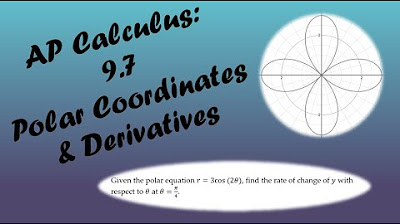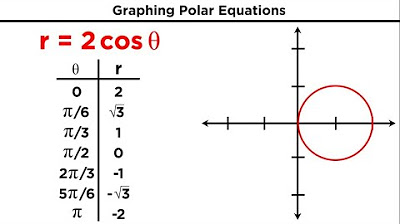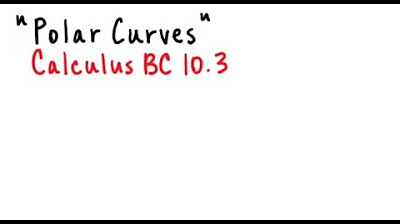Calculus 2: Polar Coordinates (Video #30) | Math with Professor V
TLDRThis video lecture introduces the concept of polar coordinates as an alternative to the Cartesian coordinate system for defining points in space. It explains the components of polar coordinates, including the pole, polar axis, radius (r), and angle (theta), and demonstrates how to plot points using these coordinates. The lecture also covers the conversion between polar and Cartesian coordinates, the process of graphing polar curves, and touches on the application of polar coordinates in calculus, including finding tangents to polar curves and converting polar equations to Cartesian form. The video provides step-by-step examples to solidify understanding and concludes with a brief overview of popular polar equations and their graphs.
Takeaways
- 📚 The video lecture introduces the concept of polar coordinates as an alternative to the Cartesian coordinate system for defining points in space.
- 📐 Polar coordinates are represented by 'r' (the distance from the pole to the point) and 'theta' (the angle from the polar axis to the line segment connecting the pole and the point).
- 📍 The pole is analogous to the origin in the Cartesian system, and the polar axis is typically aligned with the positive x-axis.
- 📈 The video demonstrates how to plot points in the polar coordinate system, emphasizing that 'r' is listed first, followed by 'theta'.
- 🔄 The script explains the concept of non-uniqueness in polar coordinates, where more than one set of polar coordinates can represent the same point.
- 🔄 The conversion between Cartesian and polar coordinates is discussed, with formulas provided to switch between 'x', 'y', 'r', and 'theta'.
- 📉 The lecture covers the process of converting equations from polar to Cartesian form, and vice versa, to facilitate graphing and analysis.
- 📈 An example is given to convert a point from Cartesian (1, -2) to polar coordinates, resulting in 'r = √5' and 'theta ≈ -63.4°'.
- 📊 The process of converting a polar equation to a Cartesian equation is shown, with an example where 'r = 2sin(theta) + 2cos(theta)' is transformed into a circle equation in Cartesian coordinates.
- 📚 The calculus aspect of polar coordinates is introduced, explaining how to find the slope of the tangent to a polar curve using 'dy/dx = (dy/dθ) / (dx/dθ)'.
- 📈 The video concludes with a summary of common polar equations for curves like circles, cardioids, limacons, and roses, and a brief example of graphing a limacon curve.
Q & A
What is the Cartesian coordinate system also known as?
-The Cartesian coordinate system is also referred to as the rectangular coordinate system or the x-y coordinate system.
Why might the Cartesian coordinate system not always be the easiest to work with?
-The script suggests that the Cartesian coordinate system might not always be the easiest to work with due to certain complexities in defining points in space, which is why alternative coordinate systems like polar coordinates are introduced.
What are the two components of a polar coordinate system used to define a point in space?
-The two components of a polar coordinate system are 'r', which represents the distance from the pole to the point, and 'theta', which represents the angle swept out from the polar axis to the line segment connecting the point and the pole.
How is the direction of 'r' affected when it is negative in polar coordinates?
-When 'r' is negative in polar coordinates, it means you go in the opposite direction along the angle 'theta' from the pole.
What does the pole represent in the polar coordinate system?
-In the polar coordinate system, the pole represents a fixed point, similar to the origin in the Cartesian coordinate system, from which distances and angles are measured.
How can you convert from rectangular (Cartesian) coordinates to polar coordinates?
-To convert from rectangular to polar coordinates, you use the formulas r = sqrt(x^2 + y^2), theta = atan(y/x), where 'r' is the radius, 'theta' is the angle in radians, 'x' and 'y' are the rectangular coordinates.
What is the significance of the angle 'theta' in polar coordinates?
-In polar coordinates, 'theta' is significant as it determines the direction of the point from the pole, with positive angles measured counterclockwise and negative angles measured clockwise.
Why are polar coordinates not unique?
-Polar coordinates are not unique because a point can be represented by multiple combinations of 'r' and 'theta', especially when considering angles greater than 2π or less than 0.
How can you convert a polar equation to a Cartesian equation?
-To convert a polar equation to a Cartesian equation, you replace 'r' with sqrt(x^2 + y^2), replace 'r*cos(theta)' with 'x', and 'r*sin(theta)' with 'y', and then simplify the equation to eliminate 'r' and 'theta'.
What is the process for finding the slope of the tangent line to a polar curve?
-To find the slope of the tangent line to a polar curve, you differentiate the parametric equations x = r*cos(theta) and y = r*sin(theta) with respect to 'theta', and then find the ratio dy/dtheta / dx/dtheta.
What are some common polar graphs encountered in calculus?
-Some common polar graphs include circles centered at the origin or along the axes, cardioids, limassons with or without inner loops, and roses, which are characterized by the number of petals determined by the coefficients of 'theta'.
Outlines
📚 Introduction to Polar Coordinates
This paragraph introduces the concept of polar coordinates as an alternative to the Cartesian coordinate system for defining points in a two-dimensional space. The polar coordinate system uses a pole, analogous to the origin in Cartesian coordinates, and a polar axis, typically aligned with the positive x-axis. The location of a point P is determined by two values: r, the distance from the pole to the point, and theta, the angle measured from the polar axis to the line segment connecting the pole and point P. The paragraph explains that while the Cartesian system is well-known, the polar system can be more convenient in certain situations, such as when dealing with problems involving circular symmetry.
📈 Plotting Points in Polar Coordinates
The second paragraph demonstrates how to plot points in the polar coordinate system. It explains that the radius (r) is listed first, followed by the angle (theta). The process involves determining the angle's quadrant and then measuring the radius from the pole. The paragraph provides examples of plotting points with positive and negative radii, illustrating how a negative radius results in a point located in the opposite direction along the angle from the pole. It also introduces the concept that polar coordinates are not unique, meaning a single point can be represented by multiple sets of polar coordinates.
🔄 Conversion Between Rectangular and Polar Coordinates
This paragraph delves into the mathematical relationship between rectangular (Cartesian) and polar coordinates, explaining how to convert between the two systems. It outlines the formulas for converting x and y coordinates to r and theta, and vice versa. The explanation includes the use of trigonometric ratios and the Pythagorean theorem to derive the formulas for r and theta. The paragraph also covers how to determine the correct quadrant for theta when converting from rectangular to polar coordinates.
📉 Converting a Specific Point to Polar Coordinates
The fourth paragraph provides a step-by-step example of converting a specific point with rectangular coordinates (1, -2) to polar coordinates. It calculates the radius (r) using the Pythagorean theorem and determines the angle (theta) using the tangent function. The summary includes the process of finding the reference angle and adjusting theta to ensure it falls within the correct quadrant. The paragraph concludes with multiple options for expressing the final polar coordinates, considering different conventions for the angle's range.
📊 Conversion of Polar Coordinates to Rectangular Coordinates
The fifth paragraph presents an example of converting a point given in polar coordinates (r = 1, theta = 7π/4) to rectangular coordinates. It simplifies the conversion by using the relationships x = r * cos(theta) and y = r * sin(theta), resulting in exact values for x and y. The summary highlights the ease of this conversion compared to the previous example and emphasizes the importance of understanding these relationships for future applications.
📐 Converting Polar Equations to Cartesian Equations
This paragraph discusses the process of converting polar equations to Cartesian equations, which can be useful for graphing and analyzing curves in the Cartesian coordinate system. It provides an example of converting the equation r * cos(theta) to a Cartesian equation by isolating x and replacing r with its equivalent expression in terms of x and y. The summary explains how to manipulate the equation to eliminate r and theta, resulting in a Cartesian equation that can be easily graphed.
📉 Calculating the Slope of Tangents to Polar Curves
The sixth paragraph explores the concept of finding the slope of the tangent line to a polar curve by treating the polar curve as a set of parametric equations. It explains the process of differentiating the parametric equations with respect to the parameter theta and then taking the ratio of the derivatives to find dy/dx. The paragraph provides a specific example where the polar curve r = 2 - sin(theta) is given, and it shows the steps to find the slope of the tangent line at theta = π/3.
📈 Graphing Polar Curves and Identifying Common Equations
The final paragraph provides an overview of common polar equations and their graphs, such as lines, circles, cardioids, limassons, and roses. It emphasizes the importance of understanding these equations for applications in calculus, especially when dealing with areas and lengths. The paragraph also offers a quick example of graphing the polar equation r = 1 - 3cos(theta), identifying it as a limaçon with an inner loop. The summary includes a step-by-step approach to plotting the curve by creating a table of theta and r values and encourages the viewer to practice plotting for a better understanding of the curve's shape.
📚 Conclusion and Future Lessons
The concluding paragraph summarizes the lesson on polar coordinates and their applications in calculus. It encourages viewers to store the information for future reference and to engage with the content by liking, subscribing, and sharing the video. The paragraph also teases upcoming lessons on integration and polar calculus, inviting the audience to stay tuned for more educational content.
Mindmap
Keywords
💡Polar Coordinates
💡Cartesian Coordinate System
💡Pole
💡Theta (θ)
💡Radius (r)
💡Conversion between Polar and Cartesian Coordinates
💡Tangents to Polar Curves
💡Graphing Polar Curves
💡Limasson
💡Rose Curves
Highlights
Introduction to polar coordinates as an alternative to the Cartesian coordinate system.
Explanation of the polar coordinate system using r (radius) and theta (angle).
The significance of the pole and polar axis in defining polar coordinates.
How to plot points in polar coordinates with examples.
The concept of negative radius values and their effect on point plotting.
Understanding the non-uniqueness of polar coordinates for the same point.
Conversion formulas between rectangular and polar coordinates.
Practical steps to convert a point from rectangular to polar coordinates with an example.
Conversion of polar coordinates to rectangular coordinates with an example.
The process of converting polar equations to Cartesian equations.
Identifying and graphing a polar curve with an example.
Finding the slope of the tangent line to a polar curve using derivatives.
Differentiating parametric equations in polar coordinates to find dy/dx.
Graphing popular polar equations like circles, cardioids, limassons, and roses.
Characteristics of roses in polar equations and their petal count.
Identifying a limaçon with an inner loop from its polar equation.
Creating a table of theta and r values for graphing polar equations.
Final graphing of a polar equation and its interpretation.
Transcripts
5.0 / 5 (0 votes)
Thanks for rating:





